Health and Social Care Job Roles and Confidentiality Report
VerifiedAdded on 2021/04/21
|10
|2387
|271
Report
AI Summary
This report provides a comprehensive overview of the health and social care sector. It begins by defining the core aims of healthcare and social care, emphasizing the importance of understanding provisions for new professionals. The report then details the three main types of health and social care provisions: statutory, private, and voluntary, giving examples such as general physicians, shelter home nurses, and aged care support. It explores self-assessment methods for these job roles and compares their responsibilities. The report further discusses how to maximize service user safety through ethical practices, awareness of potential issues, and collaboration. It highlights the significance of confidentiality, outlining rules for protecting service user information and the importance of confidentiality in maintaining trust and preventing harm. The report concludes by summarizing the key aspects covered, emphasizing the significance of ethical considerations and confidentiality in modern health and social care, along with the importance of these principles for the well-being of service users.
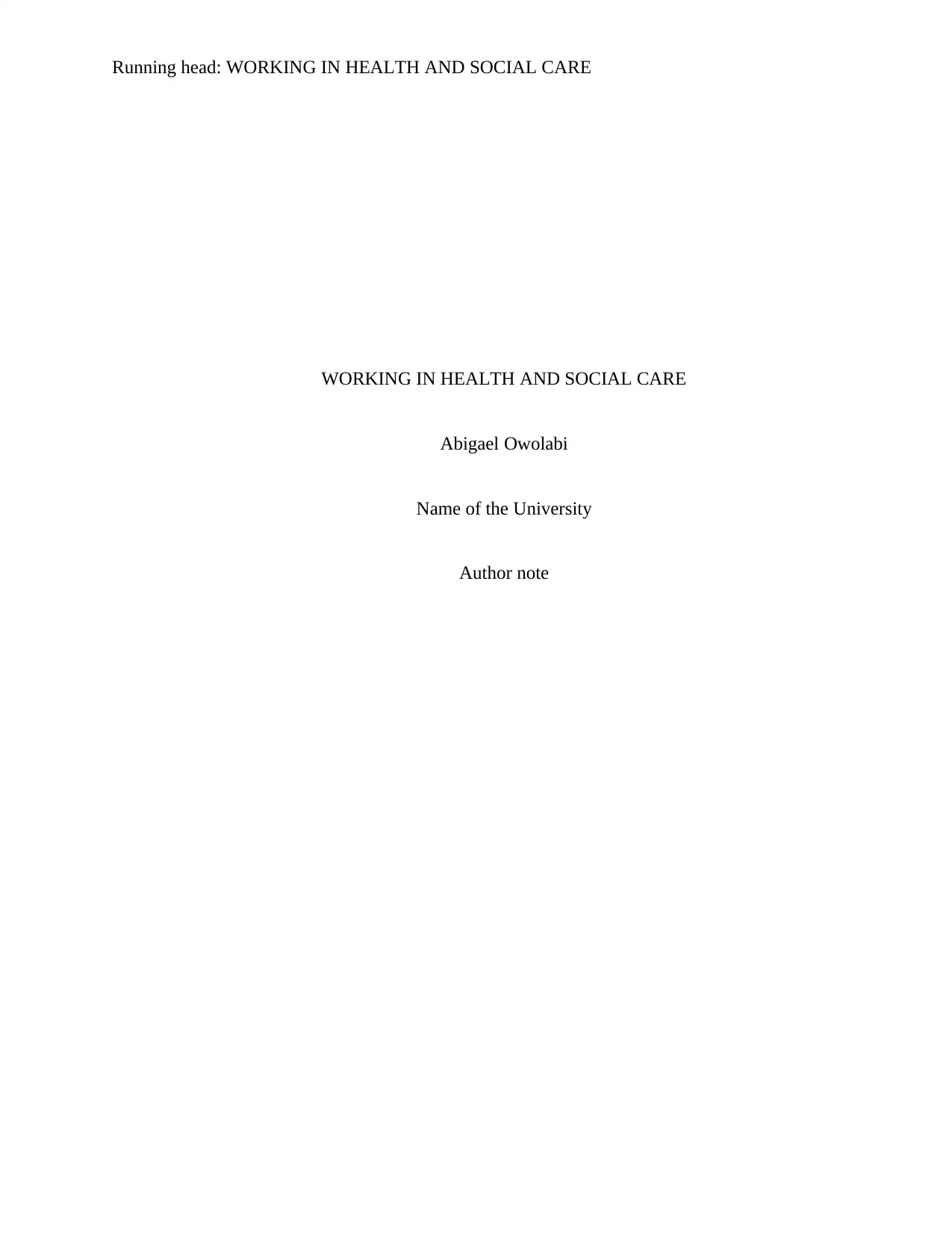
Running head: WORKING IN HEALTH AND SOCIAL CARE
WORKING IN HEALTH AND SOCIAL CARE
Abigael Owolabi
Name of the University
Author note
WORKING IN HEALTH AND SOCIAL CARE
Abigael Owolabi
Name of the University
Author note
Paraphrase This Document
Need a fresh take? Get an instant paraphrase of this document with our AI Paraphraser

1WORKING IN HEALTH AND SOCIAL CARE
Table of Contents
Introduction..........................................................................................................................2
Different health and social care provisions (2B,D2, 2B,D3)...............................................2
Comparison of three selected job roles in health and social care sector (2B,M3; 2B,P2)...3
How to maximize the safety of service users while working under job roles? (2B,P3)......3
How the right to confidentiality is protected? (2B,P4)........................................................4
Why the right to confidentiality is important for social and healthcare? (2B,M2)..............4
Conclusion...........................................................................................................................5
References............................................................................................................................7
Abigael Owolabi
Table of Contents
Introduction..........................................................................................................................2
Different health and social care provisions (2B,D2, 2B,D3)...............................................2
Comparison of three selected job roles in health and social care sector (2B,M3; 2B,P2)...3
How to maximize the safety of service users while working under job roles? (2B,P3)......3
How the right to confidentiality is protected? (2B,P4)........................................................4
Why the right to confidentiality is important for social and healthcare? (2B,M2)..............4
Conclusion...........................................................................................................................5
References............................................................................................................................7
Abigael Owolabi
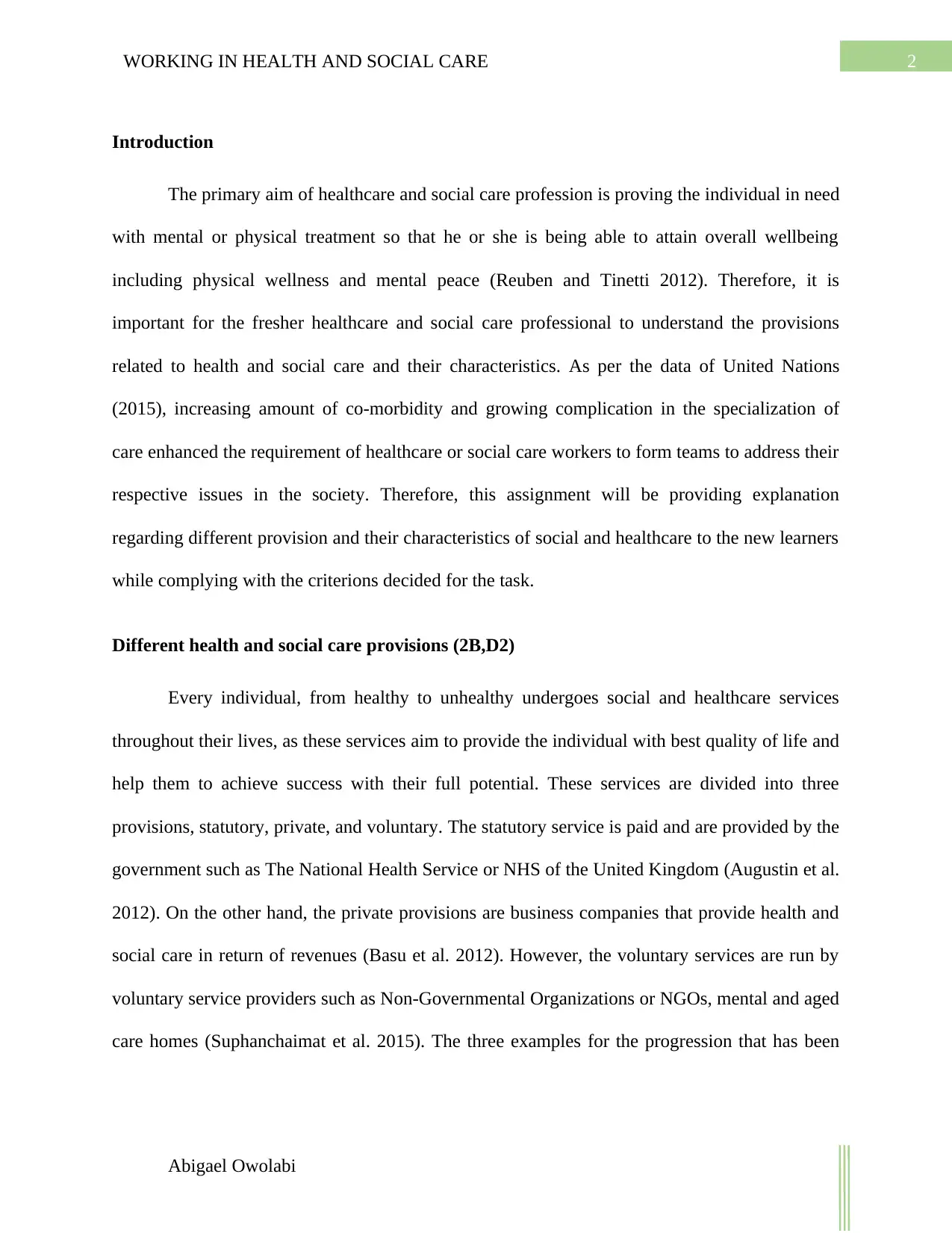
2WORKING IN HEALTH AND SOCIAL CARE
Introduction
The primary aim of healthcare and social care profession is proving the individual in need
with mental or physical treatment so that he or she is being able to attain overall wellbeing
including physical wellness and mental peace (Reuben and Tinetti 2012). Therefore, it is
important for the fresher healthcare and social care professional to understand the provisions
related to health and social care and their characteristics. As per the data of United Nations
(2015), increasing amount of co-morbidity and growing complication in the specialization of
care enhanced the requirement of healthcare or social care workers to form teams to address their
respective issues in the society. Therefore, this assignment will be providing explanation
regarding different provision and their characteristics of social and healthcare to the new learners
while complying with the criterions decided for the task.
Different health and social care provisions (2B,D2)
Every individual, from healthy to unhealthy undergoes social and healthcare services
throughout their lives, as these services aim to provide the individual with best quality of life and
help them to achieve success with their full potential. These services are divided into three
provisions, statutory, private, and voluntary. The statutory service is paid and are provided by the
government such as The National Health Service or NHS of the United Kingdom (Augustin et al.
2012). On the other hand, the private provisions are business companies that provide health and
social care in return of revenues (Basu et al. 2012). However, the voluntary services are run by
voluntary service providers such as Non-Governmental Organizations or NGOs, mental and aged
care homes (Suphanchaimat et al. 2015). The three examples for the progression that has been
Abigael Owolabi
Introduction
The primary aim of healthcare and social care profession is proving the individual in need
with mental or physical treatment so that he or she is being able to attain overall wellbeing
including physical wellness and mental peace (Reuben and Tinetti 2012). Therefore, it is
important for the fresher healthcare and social care professional to understand the provisions
related to health and social care and their characteristics. As per the data of United Nations
(2015), increasing amount of co-morbidity and growing complication in the specialization of
care enhanced the requirement of healthcare or social care workers to form teams to address their
respective issues in the society. Therefore, this assignment will be providing explanation
regarding different provision and their characteristics of social and healthcare to the new learners
while complying with the criterions decided for the task.
Different health and social care provisions (2B,D2)
Every individual, from healthy to unhealthy undergoes social and healthcare services
throughout their lives, as these services aim to provide the individual with best quality of life and
help them to achieve success with their full potential. These services are divided into three
provisions, statutory, private, and voluntary. The statutory service is paid and are provided by the
government such as The National Health Service or NHS of the United Kingdom (Augustin et al.
2012). On the other hand, the private provisions are business companies that provide health and
social care in return of revenues (Basu et al. 2012). However, the voluntary services are run by
voluntary service providers such as Non-Governmental Organizations or NGOs, mental and aged
care homes (Suphanchaimat et al. 2015). The three examples for the progression that has been
Abigael Owolabi
⊘ This is a preview!⊘
Do you want full access?
Subscribe today to unlock all pages.

Trusted by 1+ million students worldwide
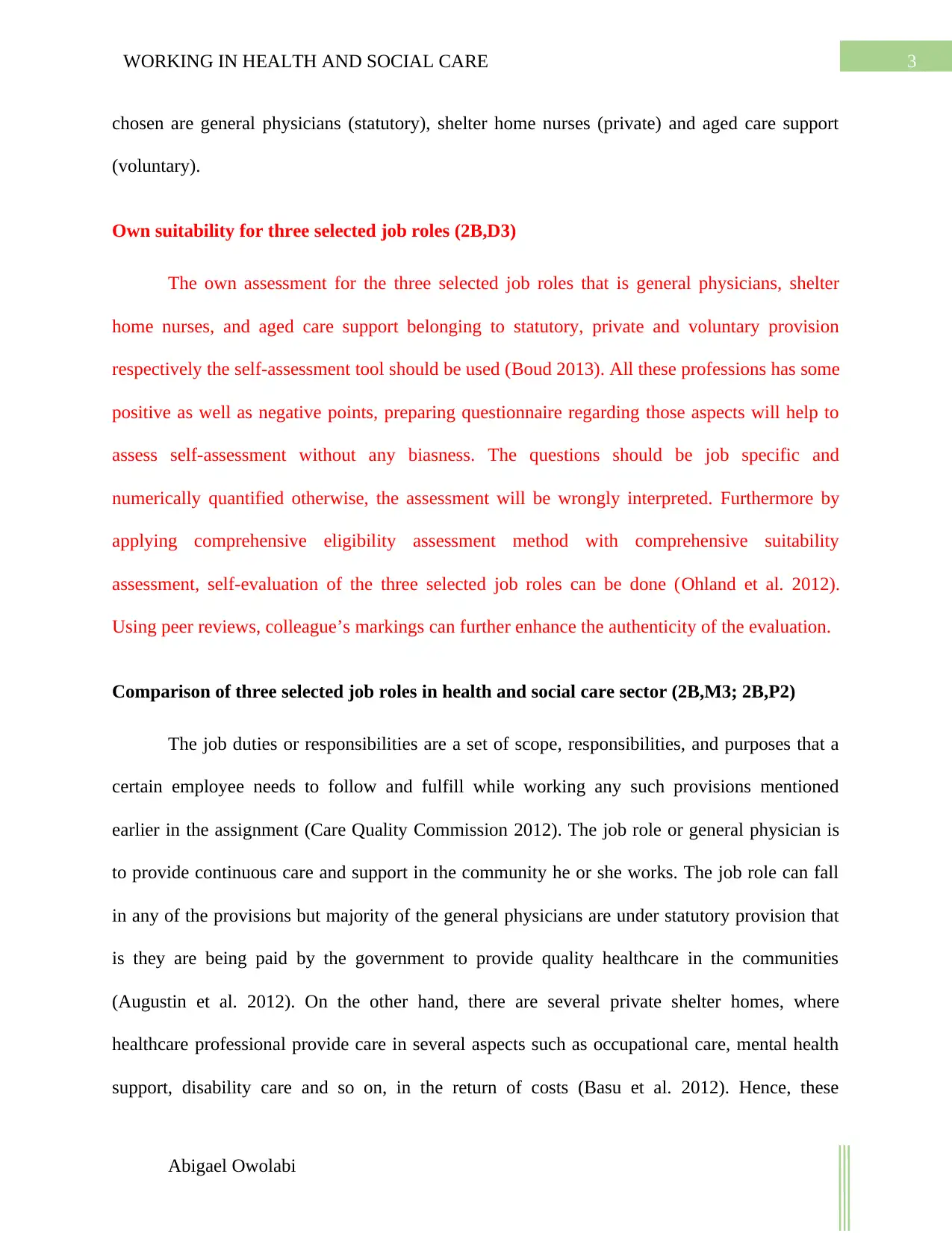
3WORKING IN HEALTH AND SOCIAL CARE
chosen are general physicians (statutory), shelter home nurses (private) and aged care support
(voluntary).
Own suitability for three selected job roles (2B,D3)
The own assessment for the three selected job roles that is general physicians, shelter
home nurses, and aged care support belonging to statutory, private and voluntary provision
respectively the self-assessment tool should be used (Boud 2013). All these professions has some
positive as well as negative points, preparing questionnaire regarding those aspects will help to
assess self-assessment without any biasness. The questions should be job specific and
numerically quantified otherwise, the assessment will be wrongly interpreted. Furthermore by
applying comprehensive eligibility assessment method with comprehensive suitability
assessment, self-evaluation of the three selected job roles can be done (Ohland et al. 2012).
Using peer reviews, colleague’s markings can further enhance the authenticity of the evaluation.
Comparison of three selected job roles in health and social care sector (2B,M3; 2B,P2)
The job duties or responsibilities are a set of scope, responsibilities, and purposes that a
certain employee needs to follow and fulfill while working any such provisions mentioned
earlier in the assignment (Care Quality Commission 2012). The job role or general physician is
to provide continuous care and support in the community he or she works. The job role can fall
in any of the provisions but majority of the general physicians are under statutory provision that
is they are being paid by the government to provide quality healthcare in the communities
(Augustin et al. 2012). On the other hand, there are several private shelter homes, where
healthcare professional provide care in several aspects such as occupational care, mental health
support, disability care and so on, in the return of costs (Basu et al. 2012). Hence, these
Abigael Owolabi
chosen are general physicians (statutory), shelter home nurses (private) and aged care support
(voluntary).
Own suitability for three selected job roles (2B,D3)
The own assessment for the three selected job roles that is general physicians, shelter
home nurses, and aged care support belonging to statutory, private and voluntary provision
respectively the self-assessment tool should be used (Boud 2013). All these professions has some
positive as well as negative points, preparing questionnaire regarding those aspects will help to
assess self-assessment without any biasness. The questions should be job specific and
numerically quantified otherwise, the assessment will be wrongly interpreted. Furthermore by
applying comprehensive eligibility assessment method with comprehensive suitability
assessment, self-evaluation of the three selected job roles can be done (Ohland et al. 2012).
Using peer reviews, colleague’s markings can further enhance the authenticity of the evaluation.
Comparison of three selected job roles in health and social care sector (2B,M3; 2B,P2)
The job duties or responsibilities are a set of scope, responsibilities, and purposes that a
certain employee needs to follow and fulfill while working any such provisions mentioned
earlier in the assignment (Care Quality Commission 2012). The job role or general physician is
to provide continuous care and support in the community he or she works. The job role can fall
in any of the provisions but majority of the general physicians are under statutory provision that
is they are being paid by the government to provide quality healthcare in the communities
(Augustin et al. 2012). On the other hand, there are several private shelter homes, where
healthcare professional provide care in several aspects such as occupational care, mental health
support, disability care and so on, in the return of costs (Basu et al. 2012). Hence, these
Abigael Owolabi
Paraphrase This Document
Need a fresh take? Get an instant paraphrase of this document with our AI Paraphraser
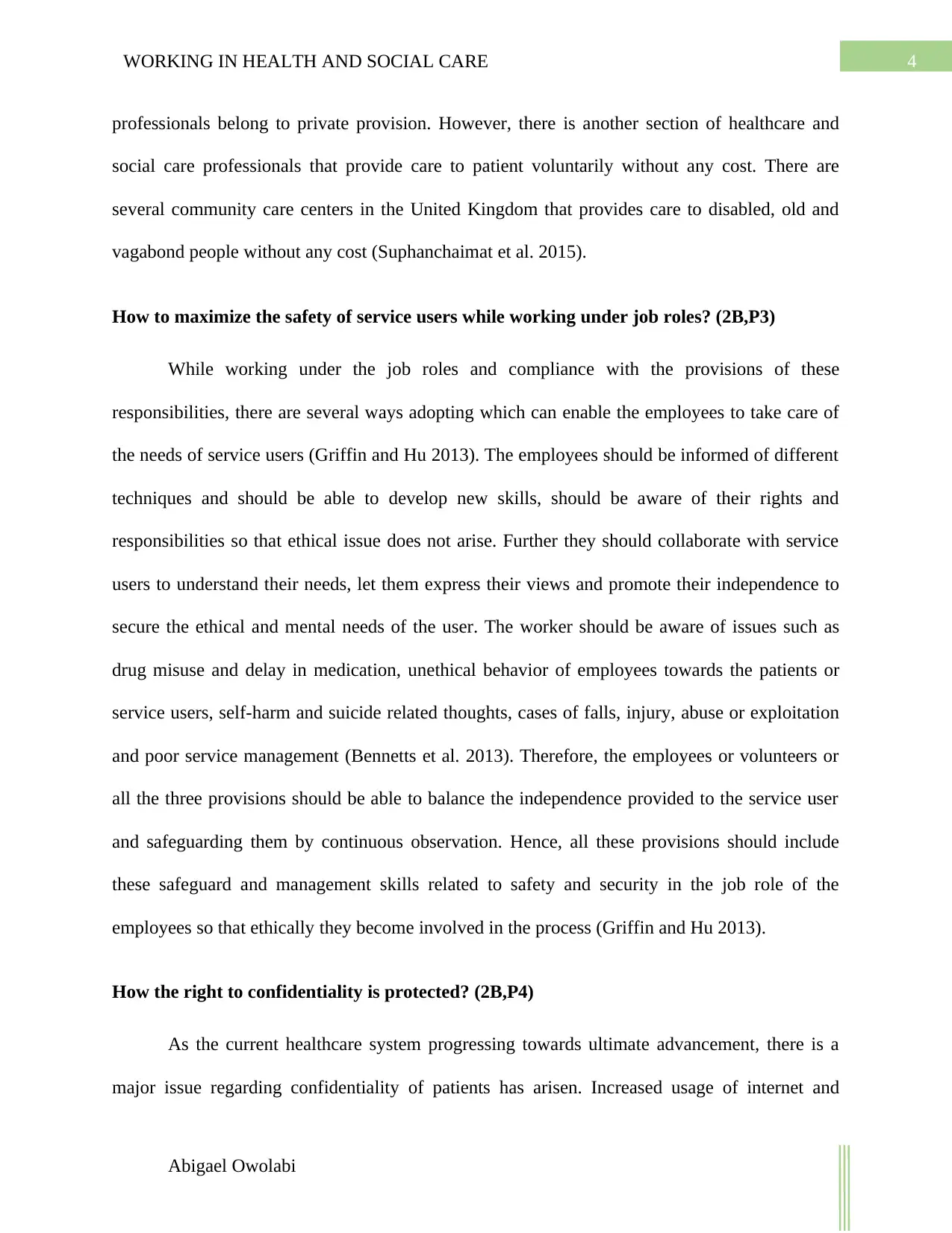
4WORKING IN HEALTH AND SOCIAL CARE
professionals belong to private provision. However, there is another section of healthcare and
social care professionals that provide care to patient voluntarily without any cost. There are
several community care centers in the United Kingdom that provides care to disabled, old and
vagabond people without any cost (Suphanchaimat et al. 2015).
How to maximize the safety of service users while working under job roles? (2B,P3)
While working under the job roles and compliance with the provisions of these
responsibilities, there are several ways adopting which can enable the employees to take care of
the needs of service users (Griffin and Hu 2013). The employees should be informed of different
techniques and should be able to develop new skills, should be aware of their rights and
responsibilities so that ethical issue does not arise. Further they should collaborate with service
users to understand their needs, let them express their views and promote their independence to
secure the ethical and mental needs of the user. The worker should be aware of issues such as
drug misuse and delay in medication, unethical behavior of employees towards the patients or
service users, self-harm and suicide related thoughts, cases of falls, injury, abuse or exploitation
and poor service management (Bennetts et al. 2013). Therefore, the employees or volunteers or
all the three provisions should be able to balance the independence provided to the service user
and safeguarding them by continuous observation. Hence, all these provisions should include
these safeguard and management skills related to safety and security in the job role of the
employees so that ethically they become involved in the process (Griffin and Hu 2013).
How the right to confidentiality is protected? (2B,P4)
As the current healthcare system progressing towards ultimate advancement, there is a
major issue regarding confidentiality of patients has arisen. Increased usage of internet and
Abigael Owolabi
professionals belong to private provision. However, there is another section of healthcare and
social care professionals that provide care to patient voluntarily without any cost. There are
several community care centers in the United Kingdom that provides care to disabled, old and
vagabond people without any cost (Suphanchaimat et al. 2015).
How to maximize the safety of service users while working under job roles? (2B,P3)
While working under the job roles and compliance with the provisions of these
responsibilities, there are several ways adopting which can enable the employees to take care of
the needs of service users (Griffin and Hu 2013). The employees should be informed of different
techniques and should be able to develop new skills, should be aware of their rights and
responsibilities so that ethical issue does not arise. Further they should collaborate with service
users to understand their needs, let them express their views and promote their independence to
secure the ethical and mental needs of the user. The worker should be aware of issues such as
drug misuse and delay in medication, unethical behavior of employees towards the patients or
service users, self-harm and suicide related thoughts, cases of falls, injury, abuse or exploitation
and poor service management (Bennetts et al. 2013). Therefore, the employees or volunteers or
all the three provisions should be able to balance the independence provided to the service user
and safeguarding them by continuous observation. Hence, all these provisions should include
these safeguard and management skills related to safety and security in the job role of the
employees so that ethically they become involved in the process (Griffin and Hu 2013).
How the right to confidentiality is protected? (2B,P4)
As the current healthcare system progressing towards ultimate advancement, there is a
major issue regarding confidentiality of patients has arisen. Increased usage of internet and
Abigael Owolabi
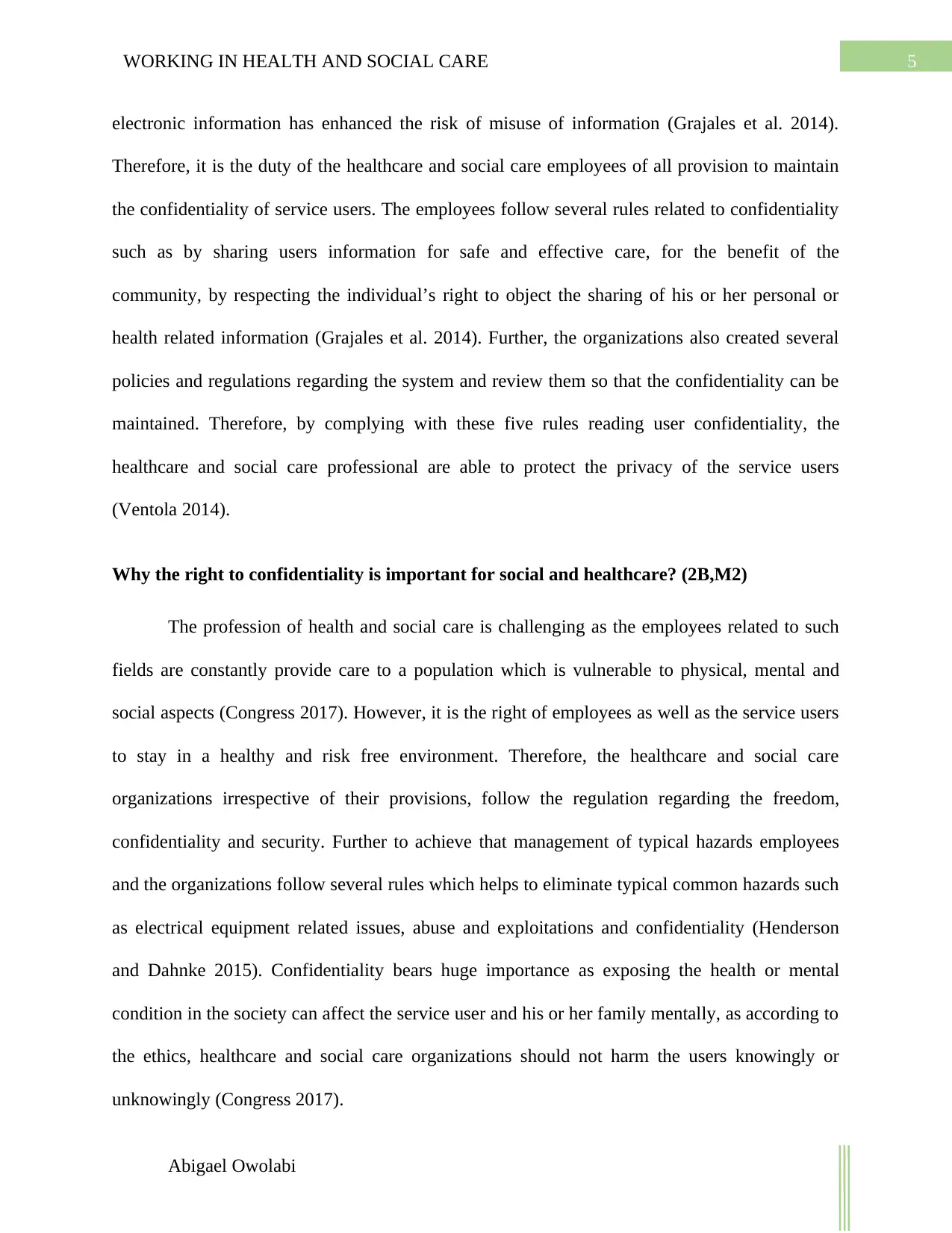
5WORKING IN HEALTH AND SOCIAL CARE
electronic information has enhanced the risk of misuse of information (Grajales et al. 2014).
Therefore, it is the duty of the healthcare and social care employees of all provision to maintain
the confidentiality of service users. The employees follow several rules related to confidentiality
such as by sharing users information for safe and effective care, for the benefit of the
community, by respecting the individual’s right to object the sharing of his or her personal or
health related information (Grajales et al. 2014). Further, the organizations also created several
policies and regulations regarding the system and review them so that the confidentiality can be
maintained. Therefore, by complying with these five rules reading user confidentiality, the
healthcare and social care professional are able to protect the privacy of the service users
(Ventola 2014).
Why the right to confidentiality is important for social and healthcare? (2B,M2)
The profession of health and social care is challenging as the employees related to such
fields are constantly provide care to a population which is vulnerable to physical, mental and
social aspects (Congress 2017). However, it is the right of employees as well as the service users
to stay in a healthy and risk free environment. Therefore, the healthcare and social care
organizations irrespective of their provisions, follow the regulation regarding the freedom,
confidentiality and security. Further to achieve that management of typical hazards employees
and the organizations follow several rules which helps to eliminate typical common hazards such
as electrical equipment related issues, abuse and exploitations and confidentiality (Henderson
and Dahnke 2015). Confidentiality bears huge importance as exposing the health or mental
condition in the society can affect the service user and his or her family mentally, as according to
the ethics, healthcare and social care organizations should not harm the users knowingly or
unknowingly (Congress 2017).
Abigael Owolabi
electronic information has enhanced the risk of misuse of information (Grajales et al. 2014).
Therefore, it is the duty of the healthcare and social care employees of all provision to maintain
the confidentiality of service users. The employees follow several rules related to confidentiality
such as by sharing users information for safe and effective care, for the benefit of the
community, by respecting the individual’s right to object the sharing of his or her personal or
health related information (Grajales et al. 2014). Further, the organizations also created several
policies and regulations regarding the system and review them so that the confidentiality can be
maintained. Therefore, by complying with these five rules reading user confidentiality, the
healthcare and social care professional are able to protect the privacy of the service users
(Ventola 2014).
Why the right to confidentiality is important for social and healthcare? (2B,M2)
The profession of health and social care is challenging as the employees related to such
fields are constantly provide care to a population which is vulnerable to physical, mental and
social aspects (Congress 2017). However, it is the right of employees as well as the service users
to stay in a healthy and risk free environment. Therefore, the healthcare and social care
organizations irrespective of their provisions, follow the regulation regarding the freedom,
confidentiality and security. Further to achieve that management of typical hazards employees
and the organizations follow several rules which helps to eliminate typical common hazards such
as electrical equipment related issues, abuse and exploitations and confidentiality (Henderson
and Dahnke 2015). Confidentiality bears huge importance as exposing the health or mental
condition in the society can affect the service user and his or her family mentally, as according to
the ethics, healthcare and social care organizations should not harm the users knowingly or
unknowingly (Congress 2017).
Abigael Owolabi
⊘ This is a preview!⊘
Do you want full access?
Subscribe today to unlock all pages.

Trusted by 1+ million students worldwide
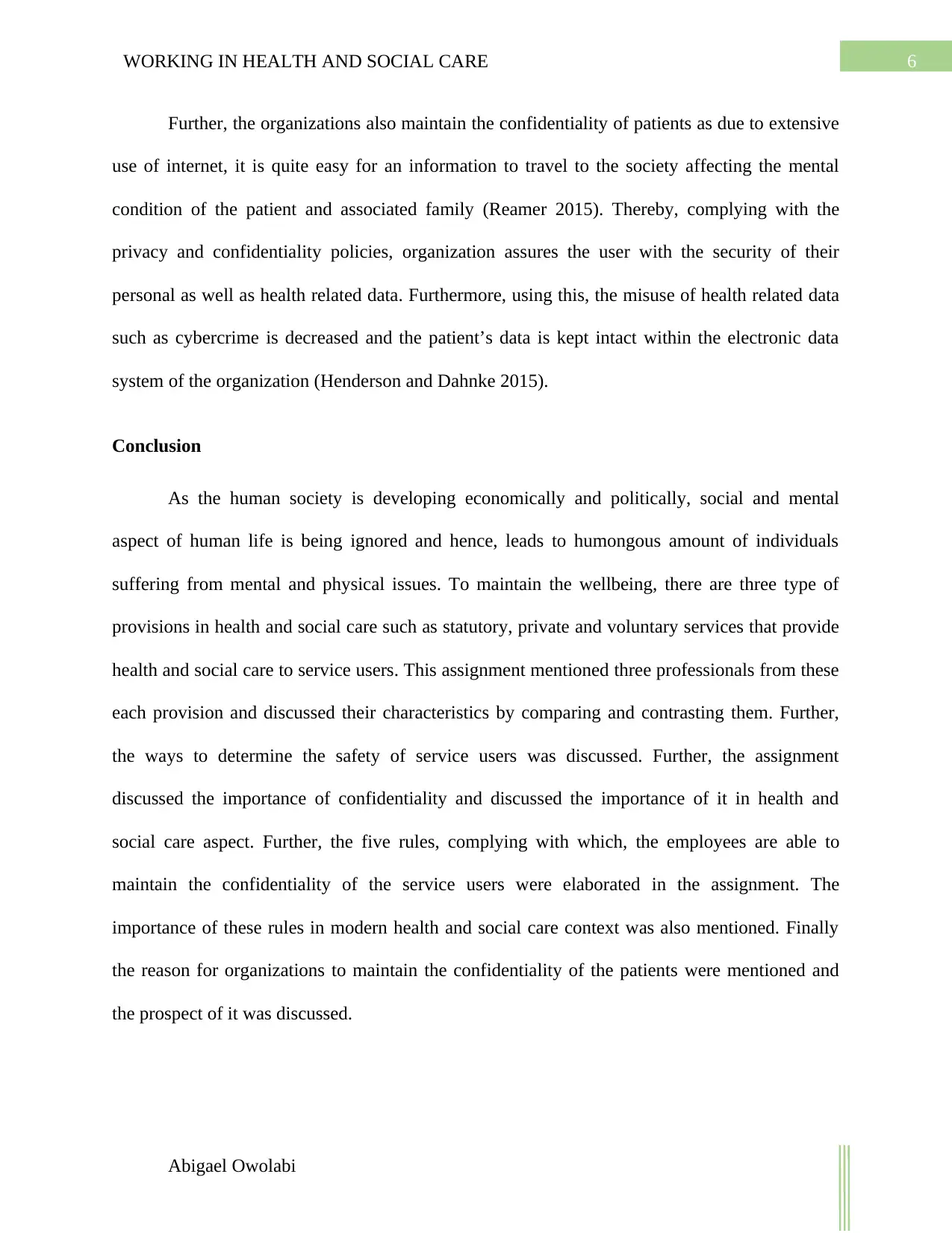
6WORKING IN HEALTH AND SOCIAL CARE
Further, the organizations also maintain the confidentiality of patients as due to extensive
use of internet, it is quite easy for an information to travel to the society affecting the mental
condition of the patient and associated family (Reamer 2015). Thereby, complying with the
privacy and confidentiality policies, organization assures the user with the security of their
personal as well as health related data. Furthermore, using this, the misuse of health related data
such as cybercrime is decreased and the patient’s data is kept intact within the electronic data
system of the organization (Henderson and Dahnke 2015).
Conclusion
As the human society is developing economically and politically, social and mental
aspect of human life is being ignored and hence, leads to humongous amount of individuals
suffering from mental and physical issues. To maintain the wellbeing, there are three type of
provisions in health and social care such as statutory, private and voluntary services that provide
health and social care to service users. This assignment mentioned three professionals from these
each provision and discussed their characteristics by comparing and contrasting them. Further,
the ways to determine the safety of service users was discussed. Further, the assignment
discussed the importance of confidentiality and discussed the importance of it in health and
social care aspect. Further, the five rules, complying with which, the employees are able to
maintain the confidentiality of the service users were elaborated in the assignment. The
importance of these rules in modern health and social care context was also mentioned. Finally
the reason for organizations to maintain the confidentiality of the patients were mentioned and
the prospect of it was discussed.
Abigael Owolabi
Further, the organizations also maintain the confidentiality of patients as due to extensive
use of internet, it is quite easy for an information to travel to the society affecting the mental
condition of the patient and associated family (Reamer 2015). Thereby, complying with the
privacy and confidentiality policies, organization assures the user with the security of their
personal as well as health related data. Furthermore, using this, the misuse of health related data
such as cybercrime is decreased and the patient’s data is kept intact within the electronic data
system of the organization (Henderson and Dahnke 2015).
Conclusion
As the human society is developing economically and politically, social and mental
aspect of human life is being ignored and hence, leads to humongous amount of individuals
suffering from mental and physical issues. To maintain the wellbeing, there are three type of
provisions in health and social care such as statutory, private and voluntary services that provide
health and social care to service users. This assignment mentioned three professionals from these
each provision and discussed their characteristics by comparing and contrasting them. Further,
the ways to determine the safety of service users was discussed. Further, the assignment
discussed the importance of confidentiality and discussed the importance of it in health and
social care aspect. Further, the five rules, complying with which, the employees are able to
maintain the confidentiality of the service users were elaborated in the assignment. The
importance of these rules in modern health and social care context was also mentioned. Finally
the reason for organizations to maintain the confidentiality of the patients were mentioned and
the prospect of it was discussed.
Abigael Owolabi
Paraphrase This Document
Need a fresh take? Get an instant paraphrase of this document with our AI Paraphraser

7WORKING IN HEALTH AND SOCIAL CARE
References
Augustin, M., Glaeske, G., Schäfer, I., Rustenbach, S.J., Hoer, A. and Radtke, M.A., 2012.
Processes of psoriasis health care in Germany–long‐term analysis of data from the statutory
health insurances. JDDG: Journal der Deutschen Dermatologischen Gesellschaft, 10(9), pp.648-
655.
Basu, S., Andrews, J., Kishore, S., Panjabi, R. and Stuckler, D., 2012. Comparative performance
of private and public healthcare systems in low-and middle-income countries: a systematic
review. PLoS medicine, 9(6), p.e1001244.
Bennetts, W., Pinches, A., Paluch, T. and Fossey, E., 2013. Real lives, real jobs: Sustaining
consumer perspective work in the mental health sector. Advances in Mental Health, 11(3),
pp.313-325.
Boud, D., 2013. Enhancing learning through self-assessment, 3rd Edn, pp. 123-145, Routledge.
Care Quality Commission, 2012. The state of health care and adult social care in England in
2011/12 (Vol. 763). The Stationery Office.
Congress, E.P., 2017. What social workers should know about ethics: Understanding and
resolving practice dilemmas. Social Work Ethics, p.1909.
Grajales III, F.J., Sheps, S., Ho, K., Novak-Lauscher, H. and Eysenbach, G., 2014. Social media:
a review and tutorial of applications in medicine and health care. Journal of medical Internet
research, 16(2).
Abigael Owolabi
References
Augustin, M., Glaeske, G., Schäfer, I., Rustenbach, S.J., Hoer, A. and Radtke, M.A., 2012.
Processes of psoriasis health care in Germany–long‐term analysis of data from the statutory
health insurances. JDDG: Journal der Deutschen Dermatologischen Gesellschaft, 10(9), pp.648-
655.
Basu, S., Andrews, J., Kishore, S., Panjabi, R. and Stuckler, D., 2012. Comparative performance
of private and public healthcare systems in low-and middle-income countries: a systematic
review. PLoS medicine, 9(6), p.e1001244.
Bennetts, W., Pinches, A., Paluch, T. and Fossey, E., 2013. Real lives, real jobs: Sustaining
consumer perspective work in the mental health sector. Advances in Mental Health, 11(3),
pp.313-325.
Boud, D., 2013. Enhancing learning through self-assessment, 3rd Edn, pp. 123-145, Routledge.
Care Quality Commission, 2012. The state of health care and adult social care in England in
2011/12 (Vol. 763). The Stationery Office.
Congress, E.P., 2017. What social workers should know about ethics: Understanding and
resolving practice dilemmas. Social Work Ethics, p.1909.
Grajales III, F.J., Sheps, S., Ho, K., Novak-Lauscher, H. and Eysenbach, G., 2014. Social media:
a review and tutorial of applications in medicine and health care. Journal of medical Internet
research, 16(2).
Abigael Owolabi

8WORKING IN HEALTH AND SOCIAL CARE
Griffin, M.A. and Hu, X., 2013. How leaders differentially motivate safety compliance and
safety participation: the role of monitoring, inspiring, and learning. Safety science, 60, pp.196-
202.
Henderson, M. and Dahnke, M.D., 2015. The ethical use of social media in nursing
practice. MedSurg Nursing, 24(1), pp.62-65.
Ohland, M.W., Loughry, M.L., Woehr, D.J., Bullard, L.G., Felder, R.M., Finelli, C.J., Layton,
R.A., Pomeranz, H.R. and Schmucker, D.G., 2012. The comprehensive assessment of team
member effectiveness: Development of a behaviorally anchored rating scale for self-and peer
evaluation. Academy of Management Learning & Education, 11(4), pp.609-630.
Reamer, F.G., 2015. Clinical social work in a digital environment: Ethical and risk-management
challenges. Clinical Social Work Journal, 43(2), pp.120-132.
Reuben, D.B. and Tinetti, M.E., 2012. Goal-oriented patient care—an alternative health
outcomes paradigm. New England Journal of Medicine, 366(9), pp.777-779.
Suphanchaimat, R., Kantamaturapoj, K., Putthasri, W. and Prakongsai, P., 2015. Challenges in
the provision of healthcare services for migrants: a systematic review through providers’
lens. BMC health services research, 15(1), p.390.
United Nations 2015. United Nations Population Aging. [online] Un.org. Available at:
http://www.un.org/en/development/desa/population/publications/pdf/ageing/
WPA2015_Report.pdf [Accessed 5 Mar. 2018].
Abigael Owolabi
Griffin, M.A. and Hu, X., 2013. How leaders differentially motivate safety compliance and
safety participation: the role of monitoring, inspiring, and learning. Safety science, 60, pp.196-
202.
Henderson, M. and Dahnke, M.D., 2015. The ethical use of social media in nursing
practice. MedSurg Nursing, 24(1), pp.62-65.
Ohland, M.W., Loughry, M.L., Woehr, D.J., Bullard, L.G., Felder, R.M., Finelli, C.J., Layton,
R.A., Pomeranz, H.R. and Schmucker, D.G., 2012. The comprehensive assessment of team
member effectiveness: Development of a behaviorally anchored rating scale for self-and peer
evaluation. Academy of Management Learning & Education, 11(4), pp.609-630.
Reamer, F.G., 2015. Clinical social work in a digital environment: Ethical and risk-management
challenges. Clinical Social Work Journal, 43(2), pp.120-132.
Reuben, D.B. and Tinetti, M.E., 2012. Goal-oriented patient care—an alternative health
outcomes paradigm. New England Journal of Medicine, 366(9), pp.777-779.
Suphanchaimat, R., Kantamaturapoj, K., Putthasri, W. and Prakongsai, P., 2015. Challenges in
the provision of healthcare services for migrants: a systematic review through providers’
lens. BMC health services research, 15(1), p.390.
United Nations 2015. United Nations Population Aging. [online] Un.org. Available at:
http://www.un.org/en/development/desa/population/publications/pdf/ageing/
WPA2015_Report.pdf [Accessed 5 Mar. 2018].
Abigael Owolabi
⊘ This is a preview!⊘
Do you want full access?
Subscribe today to unlock all pages.

Trusted by 1+ million students worldwide

9WORKING IN HEALTH AND SOCIAL CARE
Ventola, C.L., 2014. Social media and health care professionals: benefits, risks, and best
practices. Pharmacy and Therapeutics, 39(7), p.491.
Abigael Owolabi
Ventola, C.L., 2014. Social media and health care professionals: benefits, risks, and best
practices. Pharmacy and Therapeutics, 39(7), p.491.
Abigael Owolabi
1 out of 10
Related Documents
Your All-in-One AI-Powered Toolkit for Academic Success.
+13062052269
info@desklib.com
Available 24*7 on WhatsApp / Email
![[object Object]](/_next/static/media/star-bottom.7253800d.svg)
Unlock your academic potential
Copyright © 2020–2025 A2Z Services. All Rights Reserved. Developed and managed by ZUCOL.





